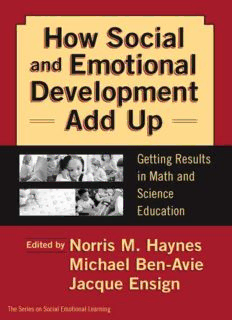
How Social and Emotional Development Add Up: Getting Results in Math and Science Education (Social Emotional Learning, 4) PDF
Preview How Social and Emotional Development Add Up: Getting Results in Math and Science Education (Social Emotional Learning, 4)
The Series on Social Emotional Learning Teachers College Press in partnership with the Center for Social and Emotional Education and the Collaborative to Advance Social and Emotional Learning (CASEL) Jonathan Cohen, Series Editor CONSULTINGEDITORS: Maurice Elias, Norris M. Haynes, Roger Weissberg, and Joseph Zins EDITORIALADVISORYBOARD: J. Lawrence Aber, Diana Allensworth, Michael Ben-Avie, Robert Coles, James P. Comer, Ann Lieberman, Pearl R. Kane, Catherine Lewis, Karen Marschke-Tobier, John O’Neil, Nel Noddings, Seymour B. Sarason, Thomas Sobol How Social and Emotional Development Add Up: Getting Results in Math and Science Education NORRISM. HAYNES, MICHAELBEN-AVIE, ANDJACQUEENSIGN,EDITORS Higher Expectations: Promoting Social Emotional Learning and Academic Achievement in Your School RAYMONDJ. PASI Caring Classrooms/Intelligent Schools: The Social Emotional Education of Young Children JONATHANCOHEN,EDITOR Educating Minds and Hearts: Social Emotional Learning and the Passage into Adolescence JONATHANCOHEN,EDITOR Social emotional learning is now recognized as an essential aspect of children’s education and a necessary feature of all successful school reform efforts. The books in this series will present perspectives and exemplary programs that foster social and emotional learning for children and adolescents in our schools, includ- ing interdisciplinary, developmental, curricular, and instructional contributions. The three levels of service that constitute social emotional learning programs will be critically presented: (1) curriculum-based programs directed to all children to enhance social and emotional competencies, (2) programs and perspectives intended for special needs children, and (3) programs and perspectives that seek to promote the social and emotional awareness and skills of educators and other school personnel. How Social and Emotional Development Add Up GETTING RESULTS IN MATH AND SCIENCE EDUCATION EDITED BY Norris M. Haynes, Michael Ben-Avie, and Jacque Ensign TeachersCollege ColumbiaUniversity NewYorkandLondon PublishedbyTeachersCollegePress,1234AmsterdamAvenue,NewYork,NY10027 Copyright2003byTeachersCollege,ColumbiaUniversity Allrightsreserved.Nopartofthispublicationmaybereproducedortransmittedinanyform orbyanymeans,electronicormechanical,includingphotocopy,oranyinformationstorage andretrievalsystem,withoutpermissionfromthepublisher. PhotographsbyMichaelJacobson-HardyandLauraBrooks. LibraryofCongressCataloging-in-PublicationData Howsocialandemotionaldevelopmentaddup:gettingresultsinmathandscience education/editedbyNorrisM.Haynes,MichaelBen-Avie&JacqueEnsign;foreword byRogerP.WeissbergandElizabethWrightWeissberg. p. cm.—(Theseriesonsocialemotionallearning) Includesbibliographicalreferencesandindex. ISBN0-8077-4307-0(cloth:alk.paper)—ISBN0-8077-4306-2(pbk.:alk.paper) 1. Mathematics—Studyandteaching. 2. Science—Studyandteaching. 3. Affective education. 4. Sociallearning. I. Haynes,NorrisM. II. Ben-Avie,Michael III. Ensign, Jacque.IV.Series. QA11.2H682003 510′.71—dc21 2002075053 ISBN0-8077-4306-2(paper) ISBN0-8077-4307-0(cloth) Printedonacid-freepaper ManufacturedintheUnitedStatesofAmerica 10 09 08 07 06 05 04 03 8 7 6 5 4 3 2 1 To Donald J. Cohen, M.D. Director, Yale Child Study Center (1983–2001) Contents Foreword, by Roger P. Weissberg & Elizabeth Wright Weissberg ix Preface, by Norris M. Haynes xiii Acknowledgments xv INTRODUCTION:Social and Emotional Development in Relation to Math and Science Learning—An Introduction to the Argument 1 Michael Ben-Avie, Norris M. Haynes, Jacque Ensign, & Trudy Raschkind Steinfeld 1. Youth Development and Student Learning in Math and Science 9 Michael Ben-Avie, Norris M. Haynes, Jayne White, Jacque Ensign, Trudy Raschkind Steinfeld, Loleta D. Sartin, & David A. Squires 2. Connecting with Students on a Social and Emotional Level Through In-Depth Discussions of Mathematics 36 John S. Zeuli & Michael Ben-Avie 3. Mathematics and Science Readiness and Policy 65 Veronica A. Roberts 4. Developmental Pathways to Mathematics Achievement 76 Judy Bippert & Nadine Bezuk 5. Success for Minority Students in Mathematics and Science: Prerequisites for Excellence and Equity 89 Dionne J. Jones vii viii CONTENTS 6. Nurturing Mathematics Learning in the Classroom 103 Jacque Ensign 7. Excellence and Equity: A Regional Consortium for Reforming Science Education 120 David Pettigrew & James Dolan 8. Stretching Students’ Future Orientation 137 Mary L. Moran with Michael Ben-Avie 9. A Corporate Partner in the Science Classroom 156 Tim Fowler CONCLUSION: Integrating Social and Emotional Development with Math and Science Learning on Every Possible Level 168 Michael Ben-Avie, Trudy Raschkind Steinfeld, Jacque Ensign, & Norris M. Haynes About the Editors and the Contributors 179 Index 183 Foreword NORRIS HAYNES, Michael Ben-Avie, Jacque Ensign, and the other con- tributors to this volume are scholarly, integrative researchers and prac- titionerswhopresentacompellingboundary-spanningmessage:Socialand emotional factors play a vital role in learning math and science, both as barriers to learning and as enhancers of learning. By presenting a substan- tial body of empirical research and sound, engaging educational strategies, this book sets the record straight: Social and emotional variables signifi- cantly influence how children learn and how they achieve in science and math.Indoingso,itestablishesalandmarkfromwhichthereshouldbeno turningback.Thisbookwillpositivelyaffecttheconceptualization,design, implementation, and evaluation of future social and emotional learning (SEL)programming(Eliasetal.,1997;Zins,Weissberg,Wang,&Walberg, in press). It also will improve the future math and science instruction that teachers provide to students. We appreciate that Haynes, Ben-Avie, and Ensign encouraged us, a father–daughterteam,towritethisforeword.Aspartofourcollaboration, the second author agreed to share a student’s perspective on how social and emotionalfactors have influencedher math performance, andthe first author offered to share perspectives on the broader research base linking social and emotional competence to academic learning. Elizabeth Wright Weissberg wrote: My dad has been a major motivator throughout my life. At one point in junior high, I was having horrible trouble with math. It wasn’t clicking and my teacher wasn’t helping either. So every night, my dad would sit down with me and help me with my math. I wasn’t always as grateful as I should have been; I sometimes got quite irritable. However, my father knew not to take it personally. I never excelled with Algebra 1, but I was able to master it with help from my father. He was what kept me going with math. Without his help, I probably would have dropped down a math level. The next year I had a wonderful math teacher. He knew exactly what he was teaching and howto teach it. Eachday the lesson plan waswell orga- ix
